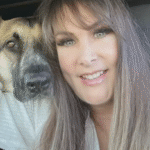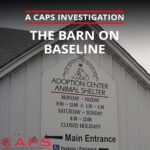Breeder: Grell , Dean and Karen
Business name: Grell’s K-D Kennel
Address: 3276 G Ave.
City, State Zip: Vail, IA 51465
Year: 2004
USDA License: 42-A-0117
USDA Inspector: Steve Bellin, ACI
USDA Inspections: 2003-12-18 (no non-compliances)
Date of CAPS Investigation: 2004-09-30
Approximately 200 dogs and three puppies (investigator suspected there were more puppies present) Breeds: Shiba Inus, Yorkshire Terriers, Cocker Spaniels, Vizslas, Miniature Pinschers, Maltese, Akitas, King Charles Cavaliers, Poodles, Pomeranians
The facility of Dean and Karen Grell’s kennel consisted of barns containing indoor and outdoor cages connected by stainless steel doggie doors. Each barn had what appeared to be white plastic siding on the walls, a peaked roof that extended about two feet over the longer walls, a door accessing each of its shorter sides, and two windows about one foot wide and one foot long on each shorter side of the building.
The walls and floorings of the outdoor cages were made of untreated, thick-gauge galvanized wire (3.6(a)(2)(xii)-Primary enclosures). Most of the cages were raised about three feet above the dirt ground on wooden stilts supporting a rectangular metal frame underneath the cage floorings
First kennel
The kennel building closest to the house was about 20 feet long and ten feet wide and had seven cages on each side. The cages were each about three feet wide, six feet long, and four feet high with no roofing. On the side of the building facing the house, one cage housed a Cocker Spaniel puppy about eight-weeks-old and two Shiba Inus about six-months-old. Another cage contained a Vizsla with enlarged breasts, suggesting she was nursing. A third cage contained an adult Cocker Spaniel, and an adjacent cage contained an adult Basset Hound. There were no dogs visible in the other three outdoor pens on that side of the building.
There was shredded paper on the floorings of the pens and on the dirt ground below them. More than a week’s accumulation of feces was under each cage (3.11(a)-Cleaning of primary enclosures), and a pile of feces about two inches high and a foot in diameter was in the middle of the Vizsla’s cage (3.11(a)-Cleaning of primary enclosures).
Second kennel
Within 30 feet of the first kennel was another building about 15 feet long and 10 feet wide. The entire side of this building facing the house was raised about a foot off the dirt ground on wooden stilts. Each side of the building had seven cages.
The outdoor cages facing the house were about two feet wide, two feet long, and two feet high, and each contained a single adult Yorkshire Terrier. The indoor cage closest to the first kennel building described contained an adult Yorkshire Terrier mother with several Yorkshire Terrier puppies about six-weeks-old, two of which the owner took out of their cage to show to me.
The outdoor cages facing the opposite direction were about two feet wide, about four feet long, and about four feet high. One cage contained a Miniature Pinscher that appeared to be pregnant, and another two cages each contained an adult Maltese.
Each outdoor cage had pieces of shredded paper in it and covering the ground below it. There appeared to be more than a week’s accumulation of feces below each cage (3.11(a)-Cleaning of primary enclosures). There was dirty buildup on the plastic siding that ran behind and under the outdoor cages, particularly closer to the ground (3.1(c)(2)-Surfaces). A six-foot-tall metal stepladder was against one of the outside caged facing the house (3.1(b)-Condition and site).
The indoor cages were each about two feet wide, three feet long, and three feet high. They had plastic walls and floorings and untreated, thick-gauge wire metal doors. Each cage had a heat lamp in it, and most of these lamps were on, except in the cage with the Yorkshire Terrier puppies. Each cage also had a lix-it style watering tube that fed into a plastic dish on the cage flooring, a plastic self-feeder attached to the door, and a layer of shredded paper about two inches thick on the flooring. Each self-feeder had a paper card with medical information about the dog inside its corresponding cage attached to each self-feeder with metal clips. There were also nine cards attached with metal clips to the inside of the door facing the direction of the first kennel building. The lights on the ceiling of the building were off at the time of investigation.
Third kennel
Another kennel building, within 30 feet of the second kennel building, was about 20 feet long and 10 feet wide and had seven outdoor cages on one side. Four of the cages, each about two feet wide, and four feet wide tall were raised about five feet above the ground on wooden stilts that supported a wooden frame underneath the cage floorings. These cages each housed an adult Yorkshire Terrier. The dirt ground below the cages was littered with shreds of paper and more than a week’s accumulation of feces (3.11(a)-Cleaning of primary enclosures).
Adjacent to these pens were three pens, each about four feet wide, six feet long, and four feet high, with treated-wire bottoms. These pens were raised about two feet off the ground on cinder blocks. The cage closest to the Yorkshire Terrier cages housed an adult Akita, the adjacent cage housed what was appeared to be an adult Labrador, and the third cage housed an adult Vizsla.
All three of these cages had several days’ accumulation of feces on their floorings. . The cage housing the Vizsla contained piles of feces, one about six inches high and six inches in diameter and another about a foot high and a foot in diameter (3.11(a)-Cleaning of primary enclosures).
Fourth kennel
More than 100 feet from the third kennel, and in the opposite direction from the house, was a kennel building about 20 feet long and 10 feet wide. The outdoor cages faced the house. These cages were about two feet wide, two feet long, and two feet high and raised about five feet above the ground. Each contained an adult Yorkshire Terrier. There was shredded paper littering the ground below the cages, but it could not be determined how much fecal accumulation there was on the ground.
Fifth kennel
There was another kennel building at the end of the property furthest from the house, about 30 feet long and ten feet wide, with one of its short sides facing the direction of the house. There were seven cages on each long side, with each cage being about four feet wide, six feet long, and four feet high. The cages were raised about four feet off the ground on wooden stilts that supported a wooden frame underneath the cage floorings. Each cage housed three to four dogs, including Poodles, King Charles Cavaliers, Miniature Pinschers, Pomeranians, and Yorkshire Terriers, grouped together by breed.
The cages on one side of the building had extra wire near the bottom of the walls, some of which was treated wire and some of which was untreated chicken wire, all of which ran about a foot high (3.6(a)(2)(xii)-Primary enclosures). In this row of cages, the cage furthest from the house had chicken wire set over the galvanized wire of its walls and housed three adult Yorkshire Terriers. In one section of this cage, the chicken wire was torn away to the extent that the dogs could reach their heads through the hole with jagged edges of wire (3.6)(a)(1)-Primary enclosures) (3.6)(a)(2)(i)(ii)(iii)-Primary enclosures). Bits of shredded paper covered the cage floorings, and the ground beneath each pen was littered with shredded paper and more than a weeks’ accumulation of feces (3.11(a)-Cleaning of primary enclosures).
Other kennels
Two other kennel buildings were near the far end of the property, within 100 feet of the fifth kennel building. Each was about 30 feet long and ten feet wide, and seven cages were visible on the long side of each building. These cages were about four feet wide, six feet long, and four feet high, and each housed two to three dogs of various breeds, including Yorkshire Terriers and Cocker Spaniels. There was shredded paper littering the ground below the cages, but it was difficult to determine the amount of fecal accumulation.




